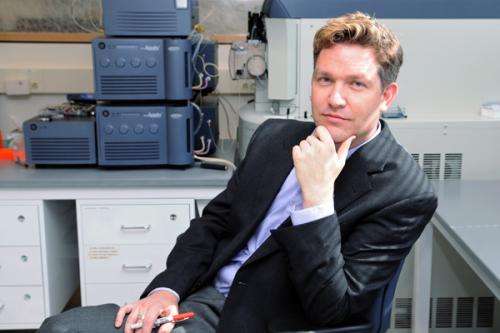Using hydrogen exchange mass spectrometry to confirm biopharmaceuticals

Biopharmaceuticals, also known as biologics, are the fastest growing sector of the pharmaceutical industry and most people living today will probably take a biopharmaceutical or know someone who takes one. Most of us are more familiar with small molecule drugs, such as aspirin, Claritin, or Lipitor, which usually consist of fewer than 100 atoms, and are created in a series of easily reproduced chemical reactions. On the other hand, biopharmaceuticals, such as insulin (a small protein), Enbrel (a fusion protein), and Humira (a monoclonal antibody), contain thousands of atoms. It is much more difficult to make them and to confirm that they were made correctly. John R. Engen, a professor of chemistry and chemical biology at Northeastern University, utilizes a technique called hydrogen exchange mass spectrometry to make confirmation a much more feasible task. His work was recently highlighted in the journal Biopharm International.
Why are biopharmaceuticals important to the affordable healthcare conversation, and what is the role of analysis in that discussion?
Since biopharmaceuticals represent a rapidly growing proportion of the pharmaceutical industry, more and more consumers are going to be exposed to them. It can be very expensive to develop and manufacture a biopharmaceutical; therefore they are often very expensive to the patient/insurance company, sometimes thousands of dollars per month. Anything that can be done to discover effective biopharmaceuticals more quickly, manufacture them more easily, or make quality control faster and more reliable will lower the costs. Better analysis methods contribute to this.
Biosimilars—the generic versions of biopharmaceuticals—may also play a role in making these drugs less expensive. The company that initially discovers and develops a protein drug, called the innovator, can eventually be in competition with copies of the protein, which are called biosimilars or follow-on biologics. Biosimilars are in many ways analogous to a generic version of a drug one might receive at the pharmacy instead of the name brand, but unlike generic small molecules, they may or may not be less expensive depending on the difficulty of manufacture. Approved biosimilars have just started entering the market, and there are ongoing conversations about how they will impact the affordability of biopharmaceuticals. One thing that is certain is biosimilars must be analyzed for quality just as the innovator biopharmaceuticals are.
Why is it difficult to analyze biopharmaceuticals?
A protein is a polymer of amino acids, and the order of the amino acids, called the sequence, is critical. The way in which the amino acids pack into a three-dimensional shape, called the structure, is crucial for proteins to work correctly. Chemically connecting the amino acids in the correct order is only possible for polymers that have fewer than about 50 amino acids. Larger proteins—a biopharmaceutical drug such as Humira with more than 650 amino acids, for example—must be made by other biological organisms, such as bacteria or mammalian cells growing in the laboratory. Protein drugs must be purified away from their host cells and then analyzed to see that the cells did the correct synthesis (the right sequence) and folded the proteins into the correct 3-D shape (the right structure). Such analyses are often done at several steps during production, purification, and even packaging.
Small changes to the growth conditions of the cells can change the final protein product and its properties. Proteins are much more delicate than small molecules and can be altered much more easily. Because many alterations interfere with correct function, meaning they inactivate or change the effectiveness of the protein as a drug, monitoring all the atoms of a biopharmaceutical is necessary. But this is a hard job. There is no one method that can simultaneously monitor all aspects, and keeping track of so many atoms is challenging.
How does your analytical technique, hydrogen exchange-Mass Spectrometry, address those challenges?
Our technique allows researchers to determine if the folded shape (the structure) of biopharmaceuticals is correct, based upon how a protein becomes labeled by a labeling agent. Analysis can be done with any size protein and at various stages of development or manufacture. The method can be used for what is called comparability analysis: making sure what is produced today is the same as what was made last month and if the procedures used to purify and package the proteins do anything to disturb the structure and function. In collaboration with the Waters Corporation in Milford, Mass., we have developed a commercial system for these mass spectrometry measurements. Many biopharmaceutical companies have adopted the system and are using it to evaluate their biopharmaceuticals.
Provided by Northeastern University


















